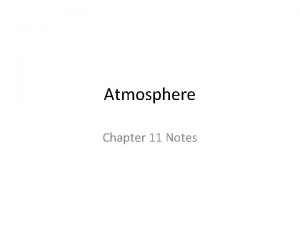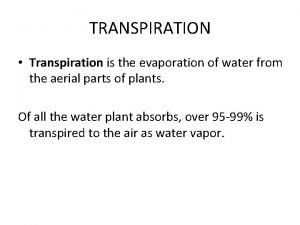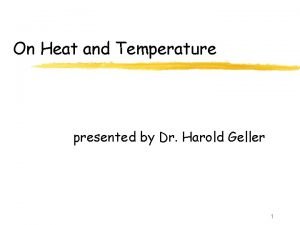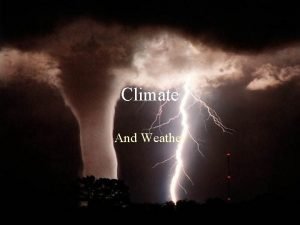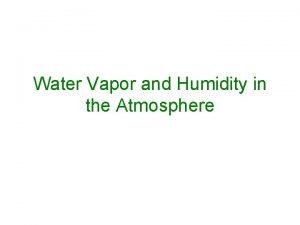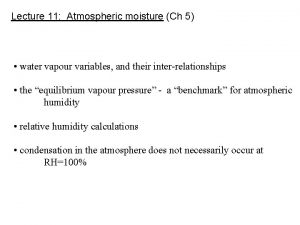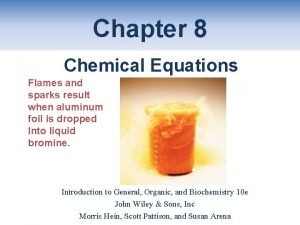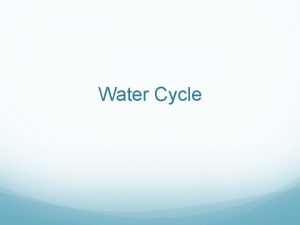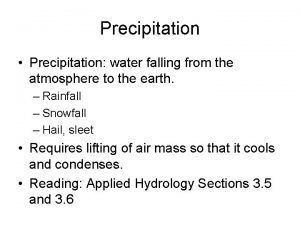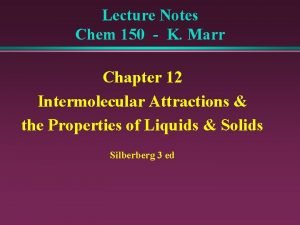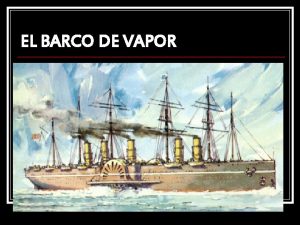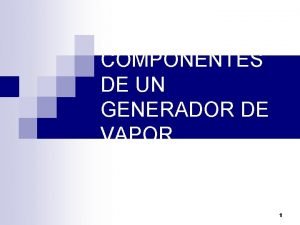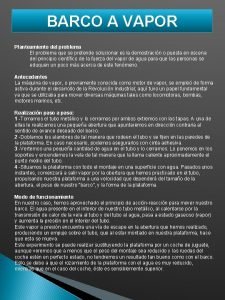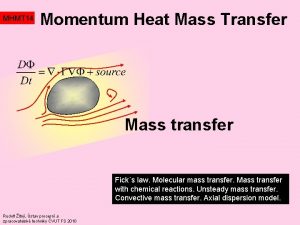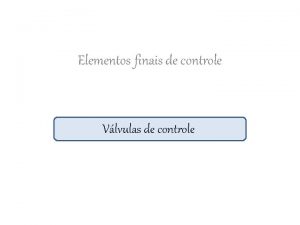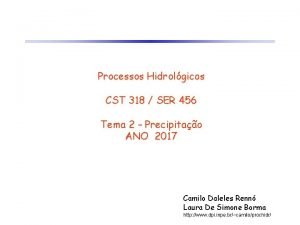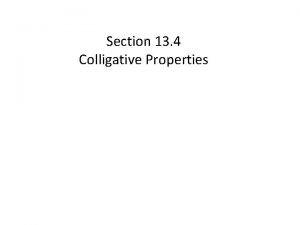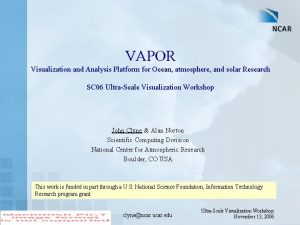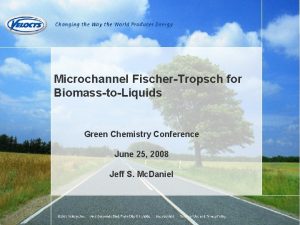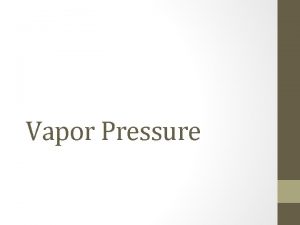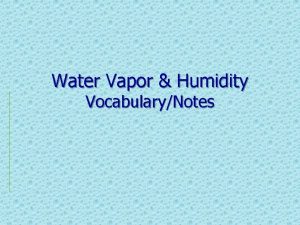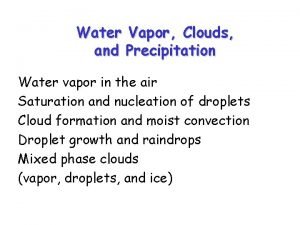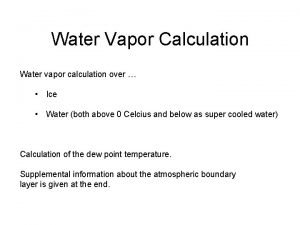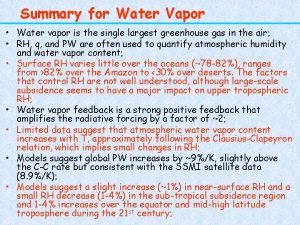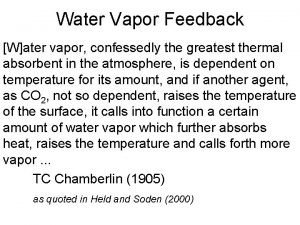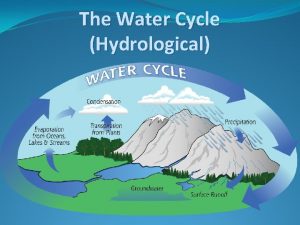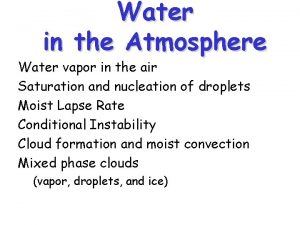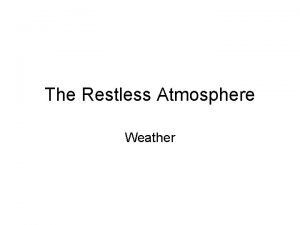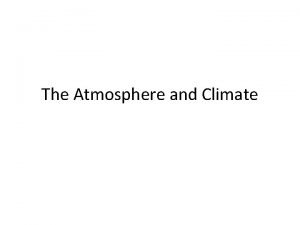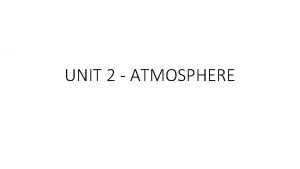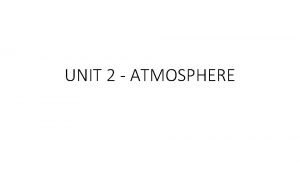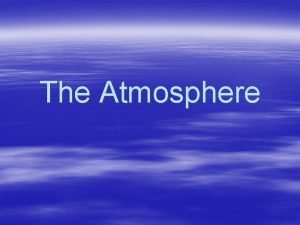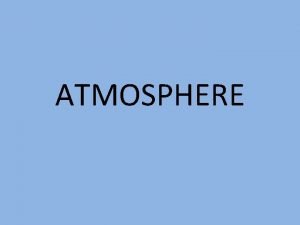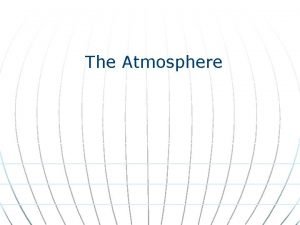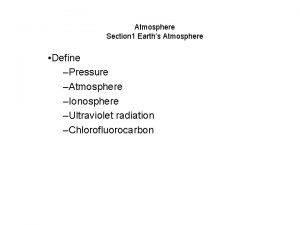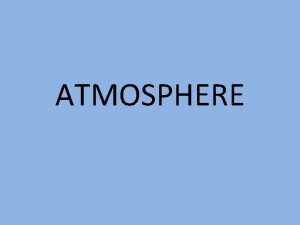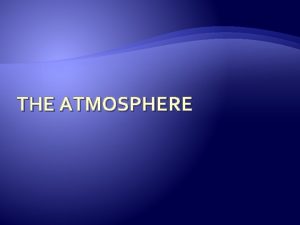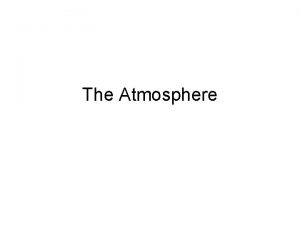Water in the Atmosphere Water vapor in the




























- Slides: 28

Water in the Atmosphere Water vapor in the air Saturation and nucleation of droplets Moist Adiabatic Lapse Rate Conditional Instability Cloud formation and moist convection Mixed phase clouds (vapor, droplets, and ice)

Molecular Structure of Water water molecule ice Water's unique molecular structure and hydrogen bonds enable all 3 phases to exist in earth's atmosphere.

“Latent” (hidden) Energy associated with phase changes

Why does it take so much energy to evaporate water? • In the liquid state, adjacent water molecules attract one another – “-” charge on O attracted to “+” charge on H – we call this hydrogen bonding • This same hydrogen bond accounts for surface tension on a free water surface – column of water “sticks together”

Water vapor saturation • Water molecules move between the liquid and gas phases • When the rate of water molecules entering the liquid equals the rate leaving the liquid, we have equilibrium – The air is said to be saturated with water vapor at this point – Equilibrium does not mean no exchange occurs

Water vapor pressure • Molecules in an air parcel all contribute to pressure • Each subset of molecules (e. g. , N 2, O 2, H 2 O) exerts a partial pressure • The VAPOR PRESSURE, e, is the pressure exerted by water vapor molecules in the air – similar to atmospheric pressure, but due only to the water vapor molecules – often expressed in mbar (2 -30 mbar common at surface)

Saturation and Temperature • The saturation vapor pressure of water increases with temperature – At higher T, faster water molecules in liquid escape more frequently causing equilibrium water vapor concentration to rise – We sometimes say “warmer air can hold more water” • There is also a vapor pressure of water over an ice surface – The saturation vapor pressure above solid ice is less than above liquid water

Water vapor is not evenly distributed throughout the atmosphere • Generally largest amounts are found close to the surface, decreasing aloft – Closest to the source - evaporation from ground, plants, lakes and ocean – Warmer air can hold more water vapor than colder air


“Relative Humidity” • Relative Humidity (RH) is ratio of actual vapor pressure to saturation vapor pressure – 100 * e/e. S – Range: 0 -100% (+) – Air with RH > 100% is supersaturated • RH can be changed by – Changes in water vapor content, e – Changes in temperature, which alter e. S

Ways to express the amount of water vapor in an air parcel • Absolute humidity – mass of water vapor/volume of air (g/m 3) – changes when air parcel volume changes • Mixing ratio – mass of water vapor/mass of dry air (g/kg) • Absolute humidity and mixing ratio remain constant as long as water vapor is not added/removed to/from air parcel • Dew point temperature

Dew • Surfaces cool strongly at night by radiative cooling – Strongest on clear, calm nights • The dew point is the temperature at which the air is saturated with water vapor • If a surface cools below the dew point, water condenses on the surface and dew drops are formed • Dew does not “fall”

Dewpoint Temperatures • Dewpoint is a measure of the water vapor content of the air • It is not a measure of temperature!

Which environment has higher water vapor content?

Condensation • Condensation is the phase transformation of water vapor to liquid water • Water does not easily condense without a surface present – Vegetation, soil, buildings provide surface for dew and frost formation – Particles act as sites for cloud and fog drop formation

Cloud and fog drop formation • If the air temperature cools below the dew point (RH > 100%), water vapor will tend to condense and form cloud/fog drops • Drop formation occurs on particles known as cloud condensation nuclei (CCN) • The most effective CCN are water soluble • Without particles clouds would not form in the atmosphere! – RH of several hundred percent required for pure water drop formation

Cloud Droplets are Tiny!

Very Small Drops Tend to Evaporate! • Surface of small drops are strongly curved • Stronger curvature produces a higher esat • Very high RH required for equilibrium with small drops – ~300% RH for a 0. 1 µm pure water drop If small drops evaporate, how can we ever get large drops? !

Nucleation of Cloud Droplets • Formation of a pure water drop without a condensation nucleus is termed “homogeneous nucleation” • Random collision of water vapor molecules can form a small drop embryo – Collision likelihood limits maximum embryo size to < 0. 01 µm • esat for embryo is several hundred percent – Embryo evaporates since environmental RH < 100. 5%

The Solute Effect • Condensation of water on soluble CCN dissolves particle – Water actually condenses on many atmospheric salt particles at RH ~70% • Some solute particles will be present at drop surface – Displace water molecules – Reduce likelihood of water molecules escaping to vapor – Reduce esat from value for pure water drop Water molecule Solute molecule

Steps in Cloud/Fog Formation • Air parcel cools causing RH to increase – Radiative cooling at surface (fog) – Expansion in rising parcel (cloud) • CCN (tenths of µm) take up water vapor as RH increases – Depends on particle size and composition • IF RH exceeds critical value, drops are activated and grow readily into cloud drops (10’s of µm)

Where do CCN come from? • Not all atmospheric particles are cloud condensation nuclei (CCN) • Good CCN are hygroscopic (“like” water, in a chemical sense) • Many hygroscopic salt and acid particles are found in the atmosphere • Natural CCN – Sea salt particles (Na. Cl) – Particles produced from biogenic sulfur emissions – Products of vegetation burning • CCN from human activity – Pollutants from fossil fuel combustion react in the atmosphere to form acids and salts

A saturated rising air parcel cools less than an unsaturated parcel • If a rising air parcel becomes saturated condensation occurs • Condensation warms the air parcel due to the release of latent heat • So, a rising parcel cools less if it is saturated • Define a moist adiabatic lapse rate – ~ 6 C/1000 m – Not constant (varies from ~ 3 -9 C) – depends on T and P

Stability and the moist adiabatic lapse rate Atmospheric stability depends on the environmental lapse rate – A rising saturated air parcel cools according to the moist adiabatic lapse rate – When the environmental lapse rate is smaller than the moist adiabatic lapse rate, the atmosphere is termed absolutely stable – What types of clouds do you expect to form if saturated air is forced to rise in an absolutely stable atmosphere? dry

Absolute instability (examples)

Conditionally unstable air • What if the environmental lapse rate falls between the moist and dry adiabatic lapse rates? – The atmosphere is unstable for saturated air parcels but stable for unsaturated air parcels – This situation is termed conditionally unstable • This is the typical situation in the atmosphere

Cloud development • Clouds form as air rises, expands and cools • Most clouds form by – Surface heating and free convection – Lifting of air over topography – Widespread air lifting due to surface convergence – Lifting along weather fronts

Fair-Weather Cumulus Clouds • Air rises due to surface heating • RH rises as rising parcel cools • Clouds form at RH ~ 100% • Rising is strongly suppressed at base of subsidence inversion produced from sinking motion associated with high pressure system • Sinking air is found between cloud elements
 Water vapor in the atmosphere percentage
Water vapor in the atmosphere percentage Vapor saturado e vapor superaquecido
Vapor saturado e vapor superaquecido Water and water and water water
Water and water and water water To beat rapidly to incorporate air and increase volume.
To beat rapidly to incorporate air and increase volume. Only water vapor evaporates through stomata.
Only water vapor evaporates through stomata. Raoult's law and dalton's law
Raoult's law and dalton's law The capacity of air to hold water vapor
The capacity of air to hold water vapor Highest clouds
Highest clouds Clausius clapeyron formula
Clausius clapeyron formula How to find vapor pressure of water
How to find vapor pressure of water Chemical reaction of phosphorus
Chemical reaction of phosphorus Run off water cycle
Run off water cycle Water vapor mixing ratio
Water vapor mixing ratio Water falling from the atmosphere
Water falling from the atmosphere Molecular attraction
Molecular attraction Barco de vapor creador
Barco de vapor creador Componentes de un generador de vapor
Componentes de un generador de vapor Barco de vapor experimento
Barco de vapor experimento Mass transport equation
Mass transport equation Partes de una maquina de vapor
Partes de una maquina de vapor Pressão de vapor
Pressão de vapor Pluviômetro
Pluviômetro Formula de las propiedades coligativas
Formula de las propiedades coligativas Vapor trail background
Vapor trail background Vapor pressure lowering
Vapor pressure lowering Vapor visualization
Vapor visualization Why freezing point decreases on adding solute
Why freezing point decreases on adding solute Vapor quality
Vapor quality Ion ion interaction
Ion ion interaction
